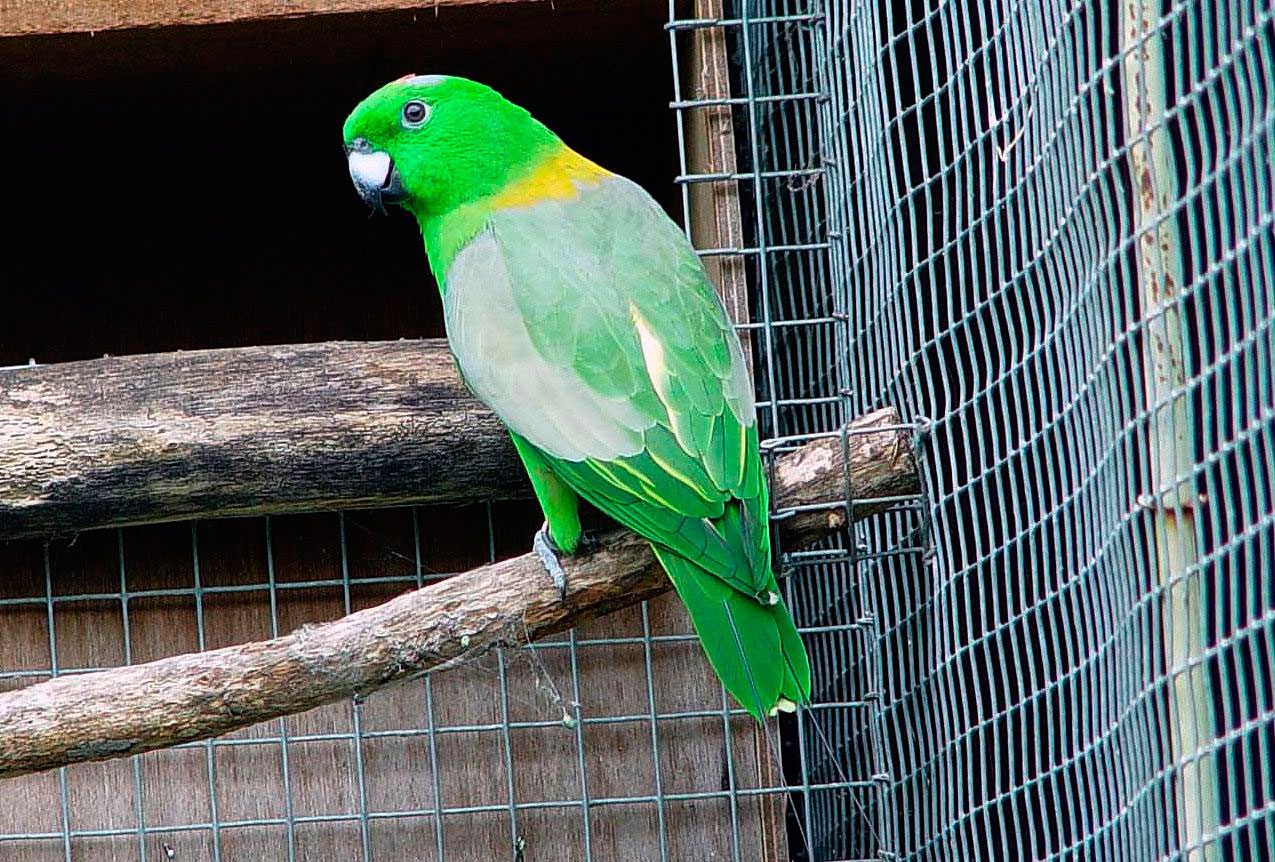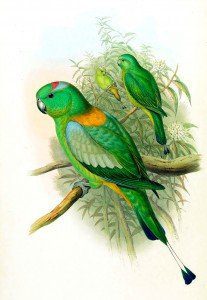Content |
|---|
Description
28 cm.. length and a weight between 200 and 225 g..
The head of the Golden-mantled Racquet-tail (Prioniturus platurus) is light green. The crown Violet gray with a red spot on the front edge; rear of the neck Ocre-Naranja. Mantle light grey, changing to green (marked in grey) on the back; rump and uppertail-coverts green. Wing coverts green, strongly impregnated with pale grey (more green in the coverts more internal); primaries Greens with vane Dark internal; secondary internal green with yellow line in the margins; bend of wing grey violet, carpal edge yellow. Wing feathers green; underside of flight feather marked in blue. Underparts brighter yellowish green, more green in the upper part of the chest, and yellow in the undertail-coverts. Upper, the tail green in the center, dotted in bluish black on the sides; undertail, the tail pale blue; spatulas blackish.
Bill pale grey, with the lower jaw and the tip of the bill darker; irises dark brown; legs grey.
The female lacks the color red and blue marks from the crown and of the collar back orange; underparts washed in less differentiated grey; rackets shorter tail.
Immature without rackets the tail.
- Sound of the Golden-mantled Racquet-tail.
Subspecies:
-
Prioniturus platurus platurus
– The nominal.
-
Prioniturus platurus talautensis
– (Hartert, E, 1898) Paler in general males; less grey on the mantle and the upper wing coverts; stain clear reddish pink on the back of the Crown with most blue patch.
The female as the nominal species but green with paler
Juveniles as the nominal species but also with the Green pale -
Prioniturus platurus sinerubris
– (Forshaw, 1971) Males with reddish pink spot away from the back of the Crown; mantle and upper wing coverts, green, slightly washed with grey; curve of wing and lesser coverts bathed in purple; smaller.
Habitat:
The Golden-mantled Racquet-tail inhabits the edges of humid forests, forests, orchards and forests of the lowlands Moss, to 2.000 m (most common above 1.000 m). The birds are seen generally in small noisy groups of 5-10 Member, flying over the forest, or during daily movements between the feeding and rest areas.
Reproduction:
A female in breeding condition was observed in October and the nest was in a hollow tree; nothing more is known about the reproductive behavior of the species.
Food:
Have been seen feeding on fruiting mango (Mangifera indica), and the diet includes fruits, seeds and flowers.
Distribution:
Size of the distribution (reproduction / resident): 186.000 km2
Restricted to Sulawesi and nearby islands, including Talaud, Siau, Lembeh, Togian, Group Banggai, Ambon, Muna and Button. Usually, the species is common and the world population is considered to be above 10.000 exemplary and stable: Nominal race numbers are calculated to be above the 10.000 birds and stable, the subspecies talautensis It is less numerous with a population of about of 5.000 specimens, and the sinerubris It is thought that it may be around 10.000 exemplary and probably stable.
Subspecies distribution:
-
Prioniturus platurus platurus
– The nominal.
-
Prioniturus platurus talautensis
– (Hartert, E, 1898) Is distributed in the Talaud Islands.
-
Prioniturus platurus sinerubris
– (Forshaw, 1971) Is distributed in Taliabu and Mangole in the Sula Islands
One of the places where you can see this bird is the Gunung Ambang nature reserve in Sulawesi.
Conservation:
• Current category of the Red List of the UICN: Least concern
• Population trend: Stable
The size of the world population It has not been quantified, Although it is estimated that it may be between 10,000 and 20,000 specimens. The species is described as common (pit et to the. 1997).
The population is suspected to be stable in the absence of evidence of any reduction or substantial threats.
"Golden-mantled Racquet-tail" in captivity:
Susceptible to fungal infections.
Rare in captivity.
Alternative names:
– Golden-mantled Racquet-tail, Gold-backed Racquet-tail, Gold-backed Racquet-tailed Parrot, Golden Mantled Racket-tailed Parrot, Golden mantled Racquet tail, Golden-mantled Racket-tail, Golden-mantled Racket-tailed Parrot, Golden-mantled Racquet-tail Parrot, Golden-mantled Racquet-tailed Parrot, Gold-mantled Racket-tail, Gold-mantled Racket-tailed Parrot, Gold-mantled Racquet-tailed Parrot (ingles).
– Palette à manteau d’or, Perroquet à raquette à manteau d’or (French).
– Goldmantelpapagei (German).
– Prioniturus platurus (Portuguese).
– Lorito Momoto Dorado, Lorito momoto Dorsidorado, Lorito-momoto Dorsidorado (español).
scientific classification:
– Order: Psittaciformes
– Family: Psittaculidae
– Genus: Prioniturus
– Scientific name: Prioniturus platurus
– Citation: (Vieillot, 1818)
– Protonimo: parrot platurus
Images "Golden-mantled Racquet-tail"
Videos "Golden-mantled Racquet-tail"
————————————————————————————————
“Golden-mantled Racquet-tail” (Prioniturus platurus)
Sources:
– Avibase
– Parrots of the World – Forshaw Joseph M
– Parrots A Guide to the Parrots of the World – Tony Juniper & Mike Parr
– Wikipedia
– Birdlife
– Photos:
(1) – Prioniturus platurus golden mantled racquet tail – Parrot-birds
(2) – “Prioniturus platurus” by John Gould – Gould, John, 1804-1881; Sharpe, Richard Bowdler, 1847-1909: Birds of Asia., Volume 6, London, [2]. Licensed under Public Domain via Wikimedia Commons.
– Sounds: Frank Lambert (Xeno-canto)


